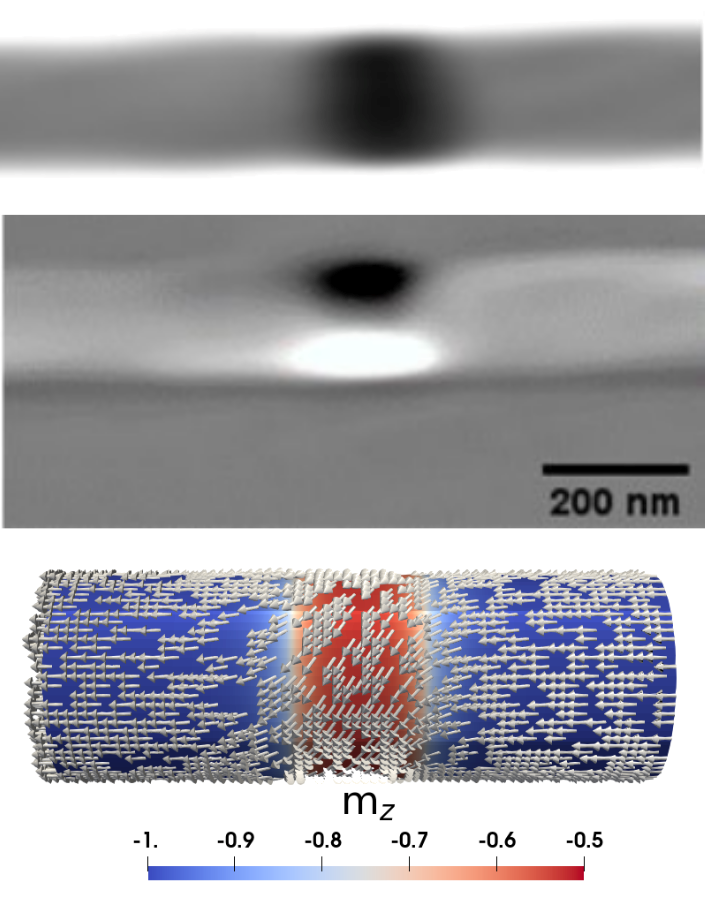
Structural (dark stands for high Fe content) and magnetic images of a modulation in a nanowire using transmission X-ray microscopy, along with a micromagnetic simulation of the same.
We combined chemical synthesis, magnetic microscopy and micromagnetic simulations to provide a comprehensive view of the micromagnetics of chemical modulations in cylindrical nanowires. This sets the ground for their use to investigate the specific aspects of domain-wall dynamics and spin waves in a curvilinear system.
Curvilinear and three-dimensional magnetism are a fast-developing field, considering the magnetic properties arising in systems with a three-dimensional shape and curved surfaces. A number specific effects have been predicted, such as effective anisotropy and Dzyaloshinskii-Moriya interactions, non-reciprocity of spin waves, interplay of chirality imposed by either shape or magnetization dynamics etc. Cylindrical nanowires are a textbook platform for exploring such physics, including spintronic effects when flowing a spin-polarized current through them. Introducing chemical modulations along such wires would provide an extra handle to control domain walls and spin waves in such investigations. Reports are emerging on the matter, however a general picture of the physics at play has not been drawn.
We considered nanowires of diameter ≈100 nm, consisting of longitudinally-magnetized segments of the soft-magnetic permalloy material, Fe20Ni80, separated by Fe-rich platelets of width a few tens of nanometers. These are grown by pulsed electroplating from a single bath in porous anodized alumina template. Following dissolution of the template, individual nanowires are contacted electrically on Si wafers to conduct electron transport and operando magnetic imaging. The latter revealed curling of magnetization around the axis at the modulations. This results from an attempt to screen magnetostatic charges arising at their interfaces due to the mismatch of magnetization. We described the situation analytically to derive scaling laws, which we refined with micromagnetic simulations, all consistent with the experimental findings. Curling increases with platelet thickness until reaching a plateau, when interfacial charges are screened. Curling, either clockwise or anticlockwise, can be controlled by the Œrsted field created by an electric current flowing in the wire. The current threshold is in the range 0.1-10×1012 A/m2, following a reentrant behavior versus modulation width, reaching a maximum when the curling plateau is reached.
This investigation is the first to provide a comprehensive overview of the micromagnetics of such chemical modulations. It has been made possible by combining advanced expertise in chemical synthesis, magnetic imaging, electric transport and micromagnetic modelling. We believe that this new knowledge will prove valuable when using such modulations to control the dynamics of domain walls of spin waves, either for the sake of fundamental spintronic physics or for device demonstrators. More generally, this demonstrates how chemical modulations may bring more richness to three-dimensional and curved systems.
Teams: Spin textures, Theory and simulation
Collaboration: IMDEA Madrid (Spain), Institut Néel (Grenoble), synchrotrons SOLEIL and ALBA
Funding: ANR Matemac-3D, Renatech, METSA
Further reading: Micromagnetics of magnetic chemical modulations in soft-magnetic cylindrical nanowires,L. Álvaro-Gómez et al., Phys. Rev. B 106, 054433 (2022). Open access: hal-03668833.
Contact: Aurelien Masseboeuf, Daria Gusakova, Olivier Fruchart




